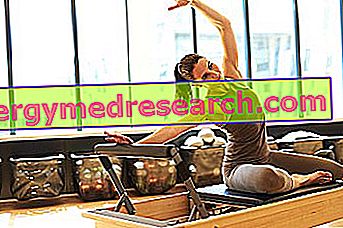Lose weight with Pilates
Pilates for weight loss: introduction
Pilates is a type of motor activity with alleged therapeutic and functional effects.

Today considered a fitness or wellness discipline, pilates is also often used for weight loss.
General information on pilates
Pilates, originally called "contrology", was born at the beginning of the 20th century by Joseph Pilates, a personal trainer of German nationality.
Currently known throughout the world, pilates has spread mainly to western countries such as Canada, the United States and the United Kingdom; the statistics indicate that, in 2005, as many as 11 million Americans have ventured into pilates.
Pilates is based on the execution of specific movements that we could commonly call "exercises" or "positions" or "figures". What distinguishes the method is the attention to factors as important as, often, neglected; for example: pulmonary ventilation, mental concentration, movement control, body centralization, gesture economics, postural alignment, precision movements and relaxation.
Premise on weight loss
Before expressing an opinion on the slimming effectiveness of pilates it is advisable to clarify a little.
First of all, remember that "losing weight" means reducing the amount of fat in adipose tissue; only consequently, but not necessarily, this leads to a decrease in body weight.
To lose weight it is essential to consume more energy than that introduced with food. It is an undisputed and more important principle than any other metabolic detail. It does not matter how, but in order to draw on the fat reserves, it becomes necessary to create a negative energy balance. To reduce adipose tissue by 100 g, it is essential to consume 700 kcal more than normal; it could therefore be stated that each kilogram of adipose content corresponds to about 7000 kcal. It is estimated that to reduce weight 3 kg a month it is essential to reduce the total energy of the diet by 30%.
If you want to create a negative energy balance, you can intervene in two ways: reduce calories or increase consumption. It is also possible to intervene mildly on the extent of the body's metabolism but it is, as we have said, a secondary precaution. We deliberately omit the power supply by postponing the reading to a dedicated article (low-calorie slimming diet).
As for the increase in motor activity, there would be much to say. Sport helps you lose weight thanks to two mechanisms:
- Direct fat consumption, maximum in prolonged aerobic disciplines at low or medium intensity such as slow running
- Increased oxygen debt and therefore post-exercise metabolism, maximum in anaerobic or high intensity mixed disciplines such as specific protocols such as Insanity Training.
It should be emphasized, however, that the "ideal" motor practice is not the most effective, but the one that takes place most willingly. Pilates, as we shall see, is certainly not the slimming discipline par excellence; however, if appreciated, it will ensure greater continuity and commitment than any other.
Effectiveness
Does pilates make you lose weight?
Does pilates make you lose weight? Maybe. The answer depends above all on how many calories you make with your diet. It is possible to tap into the reserves of adipose tissue (fat) only when the energy balance is negative. Therefore, leaving the diet unchanged (normocaloric), starting to practice pilates (which increases global energy consumption) it is possible to facilitate weight loss.
Is Pilates one of the slimming activities par excellence? No. Pilates is a discipline that is based on achieving and maintaining certain body positions, correcting balance defects, posture, improving the tone of certain weak muscles, etc. Fatigue results mainly from intense muscular tension, of a mixed type (concentric, eccentric and isometric), in which creatine phosphate and sugars are consumed. To lose weight it is instead necessary that the muscular work triggers the aerobic metabolism, possibly with a medium-low intensity range, encouraging the consumption of fats; or, as we have said, that increases post-exercise metabolism (super intense activities or at least exhaustion). Pilates has none of these characteristics.
Having said that, it is necessary to examine another important consideration: practicing sports it is inevitable that we should eat more than normal. This is because the body requires not only more energy, but also more essential nutrients, in particular minerals and vitamins. If the motor activity is of moderate volume and intensity, the problem does not arise. On the contrary, when it reaches very high thresholds, the matter gets complicated. In this case we must deal with both the substantial increase in nutritional requirements and the increase in appetite. Obviously we are talking about protocols with goals other than weight loss, such as the competitive power of swimming, cycling, boxing, running, artistic gymnastics, rowing, etc. Even in these, however, it may be necessary to lose weight, a goal that is not always easy to achieve without compromising sports performance.
In this sense, pilates offers two advantages. First of all it DOES NOT cause total physical exhaustion, both in muscular and metabolic terms. This does not mean that it is a mild activity but, due to its characteristics (the natural load in specific positions), it does not tire the organism like certain other sports. Secondly, it is a discipline that can be easily adapted to one's needs, which does not impose high rhythms. While in other activities it is the diet that adapts to physical effort, in the pilates the opposite can occur, facilitating the search for goals such as weight loss, improvement of posture, balance, etc.
Other considerations on pilates
It is not solidly demonstrated that practicing Pilates can alleviate joint and muscle diseases (for example low back pain) or reduce the incidence of invalidating falls in the elderly (although there is a general improvement in the motor balance).
Pilates is not considered effective in the treatment of any ailment or medical condition. Instead, it has been shown that healthy adults, by regularly testing pilates sessions (compared to a sedentary population), can achieve positive muscle conditioning.



